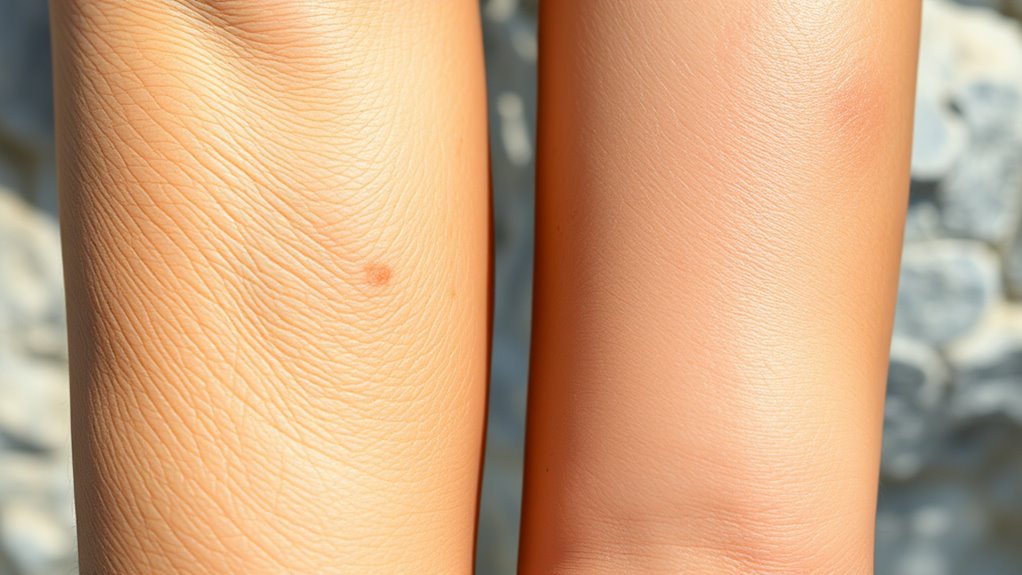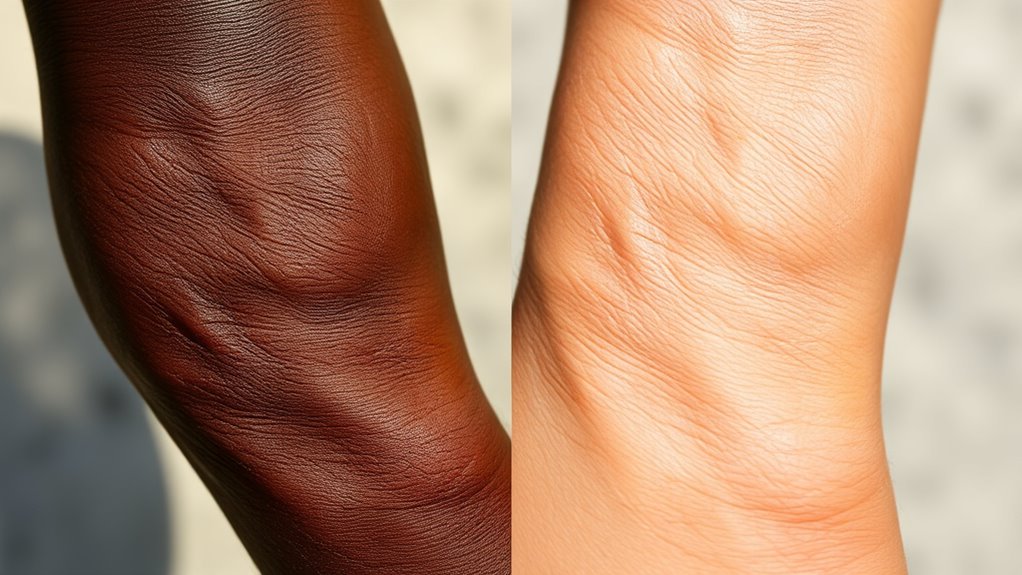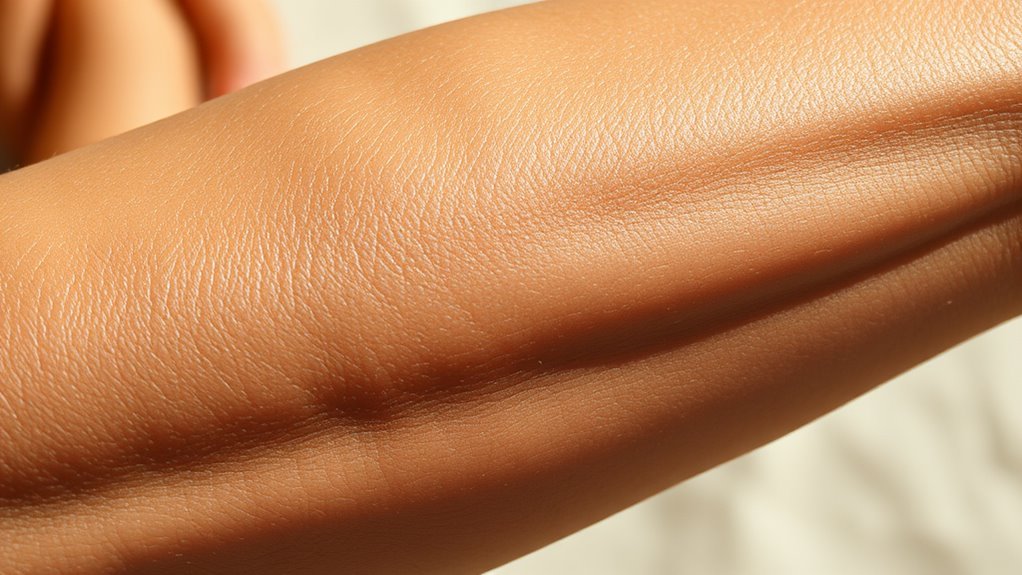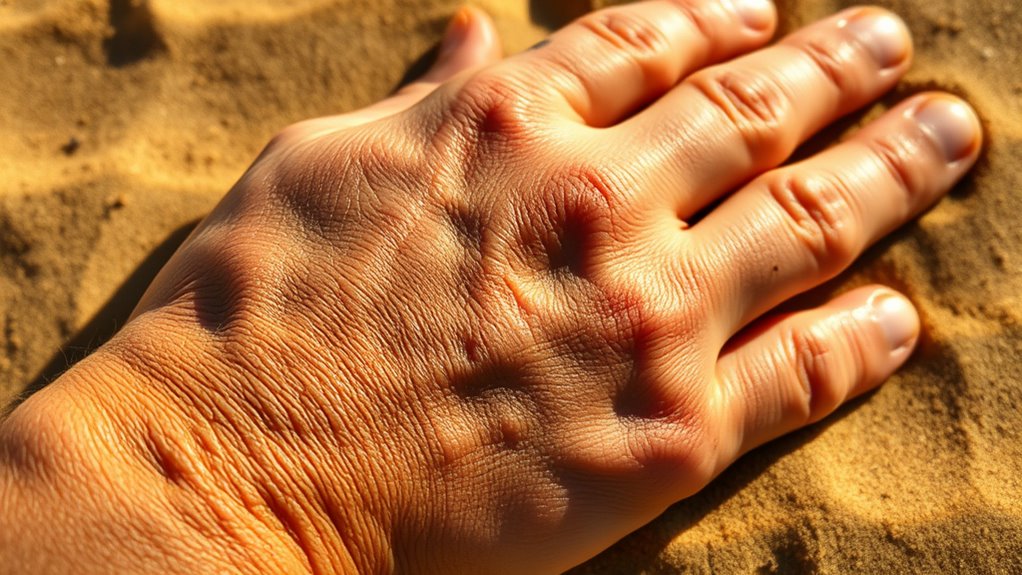Tanning accelerates skin aging by causing permanent damage to collagen, elastin, and skin cells, leading to wrinkles, sagging, and uneven tone over time. UV rays also increase melanin production, which can cause dark spots that may last years. This damage is often irreversible and weakens your skin’s structural support, making it less resilient. To protect your skin’s future health, understand how sun exposure impacts aging and learn effective ways to shield yourself.
Key Takeaways
- Prolonged UV exposure damages collagen and elastin, leading to premature wrinkles, sagging, and reduced skin elasticity.
- Tanning accelerates skin aging by increasing oxidative stress and reactive oxygen species that harm skin cells and structural proteins.
- UV-induced DNA mutations cause irreversible cellular damage, resulting in pigmentation issues, age spots, and increased skin cancer risk.
- Repeated UV exposure impairs skin’s ability to repair, causing lasting texture irregularities, dullness, and uneven tone.
- Consistent sun protection helps mitigate long-term aging effects and maintains healthier, more youthful skin.
Understanding How UV Rays Accelerate Skin Aging

Ultraviolet (UV) rays from the sun actively accelerate skin aging by damaging its structural components. UVA rays penetrate deep into the dermis, harming collagen and elastin fibers that keep your skin firm and elastic. UVB rays primarily target the outer layer, causing DNA damage that results in sunburn and triggering early aging signs. Both types contribute to photoaging through different mechanisms, weakening the skin’s foundation. UV exposure also induces oxidative stress, increasing harmful reactive oxygen species that damage skin cells and enzymes responsible for maintaining skin integrity. This process is further compounded by the cumulative nature of UV exposure, which gradually worsens skin damage over time. The shelf life of skin cells and their ability to repair themselves diminishes with ongoing UV damage, leading to more pronounced signs of aging. This decline is also influenced by skin cell turnover, which slows as we age, reducing the skin’s ability to recover from damage. In addition, the body’s natural repair mechanisms become less efficient as we age, making early damage harder to fix. The decreased efficiency of these cell renewal processes accelerates the visible effects of skin deterioration. Over time, this damage leads to a loss of collagen, sagging, wrinkles, uneven texture, and pigmentation changes. The cumulative effect of UV radiation markedly accelerates the visible signs of aging, making sun protection essential for healthier skin.
The Role of Melanin and Its Limitations

Have you ever wondered how your skin’s natural pigment protects against sun damage? Melanin acts as a broadband UV absorbent, offering natural protection. Darker skin, with higher melanin levels, has a sun protection factor of about 13, compared to light skin’s 3. It also has antioxidant properties that help combat oxidative stress and free radicals. Because of this, skin with more melanin tends to show signs of aging about 10 years later. However, melanin’s protection isn’t foolproof. Excess melanin can cause hyperpigmentation, especially after inflammation or sun exposure, leading to uneven skin tone. While melanin reduces the risk of skin damage and cancer, it doesn’t eliminate it completely—prolonged UV exposure still poses risks. Melanin’s role is essential but has its limitations. Additionally, UV protection methods like sunscreen and protective clothing are vital to further reduce skin damage risk.
Damage to Skin Elastin and Loss of Elasticity

Sun exposure and tanning beds directly damage the elastin fibers in your skin’s dermis, undermining its elasticity and resilience. UV rays cause these fibers to degrade and become disorganized, leading to solar elastosis—a buildup of abnormal elastin material that replaces healthy tissue. Damaged elastin fibers can’t stretch or recoil properly, causing sagging, wrinkles, and a leathery texture. Once elastin is broken down, it regenerates very slowly, often taking years, and aging further hampers production. Over time, normal elastic fibers clump and fragment, weakening the skin’s structural support. This loss of elastin reduces skin firmness, making it look thinner, less plump, and more prone to sagging. Tanning accelerates this damage, causing your skin to age prematurely and lose its natural resilience. Additionally, oxidative stress from UV exposure further exacerbates elastin damage by generating free radicals that attack skin cells. Understanding the vulnerabilities of AI models highlights the importance of ongoing safety measures to prevent further issues.
Visible Signs of Premature Aging Caused by Tanning

Tanning accelerates visible signs of premature aging, making your skin look older than it truly is. You’ll notice wrinkles and fine lines forming earlier, especially around the eyes and mouth, due to collagen breakdown caused by UV rays. Repeated tanning promotes deep wrinkles along expression lines and sun-exposed areas. Hyperpigmentation appears as dark age spots that won’t fade, often on your face and hands, marking permanent sun damage. Skin dryness and roughness increase as UV impairs moisture retention, giving your skin a fragile, flaky texture. Tanned skin also loses its natural glow, appearing dull and blotchy because UV damage disrupts skin renewal. Additionally, you might see broken blood vessels and redness, as UV weakens blood vessel walls, leading to an aged, uneven complexion.
The Irreversible Nature of Tanning-Induced Skin Damage

The damage caused by tanning goes beyond surface-level changes and results in lasting harm to your skin’s cellular structure. UV radiation damages your skin cells’ DNA, compromising their function and integrity. This damage is often irreversible, especially since UVA rays penetrate deeper, causing more severe harm. Once DNA mutations occur, they can lead to malfunctioning cells and increase your risk of skin cancer, including melanoma, basal, and squamous cell carcinomas. The damage also disrupts your skin’s repair mechanisms, leading to permanent changes in texture, elasticity, and tone. No topical treatment or intervention can fully undo this cellular harm. Additionally, resources and tools available for skin protection highlight the importance of preventative measures before damage occurs. Emerging research emphasizes that these long-term effects are cumulative and can manifest years after sun exposure. Over time, these irreversible mutations and structural damages accumulate, underscoring that tanning’s effects are long-lasting and often permanent. The importance of skin protection cannot be overstated in preventing further irreversible damage. Moreover, ongoing scientific studies continue to reveal the extent of UV-induced cellular damage, reinforcing the need for vigilance in sun safety practices. Furthermore, understanding protective strategies such as appropriate clothing and sunscreen use can significantly reduce the risk of long-term harm.
How Frequent Tanning Contributes to Wrinkles and Fine Lines

Frequent exposure to UV radiation from tanning accelerates the aging process by damaging the skin’s structural proteins. UV rays break down collagen and elastin fibers, which provide skin firmness and elasticity. This damage causes your skin to lose its natural resilience, leading to sagging and the development of wrinkles. UV exposure also causes the production of abnormal elastin, which is disorganized and ineffective, further promoting wrinkle formation. Additionally, enzymes triggered by UV light degrade collagen, impairing your skin’s ability to repair itself. The effects accumulate over time, making wrinkles more pronounced with continued tanning. Without protection, your skin becomes less elastic and more prone to deep lines, highlighting that frequent tanning markedly speeds up the appearance of fine lines and wrinkles. Skin aging can be exacerbated by Lifestyle factors such as stress and inadequate skincare routines, making it even more important to protect your skin from UV damage. Moreover, the long-term consequences of UV exposure include not only premature aging but also increased risk of skin cancer. Recognizing the role of UV damage in skin deterioration emphasizes the importance of sun protection measures to maintain youthful skin. Incorporating mindfulness practices and positive health habits can also support overall skin health and resilience over time.
The Impact of UV Exposure on Skin Texture and Tone

Long-term UV exposure can substantially alter your skin’s texture and tone by damaging essential structural proteins and triggering pigment changes. UV rays break down collagen and elastin, making your skin rougher and less elastic, which leads to sagging and uneven surfaces. Over time, DNA damage from UV radiation causes inflammation and further textural irregularities. Without proper moisturization, these effects worsen, speeding up aging signs. UV exposure also stimulates melanin production, resulting in uneven skin tone and blotchy patches. The loss of elasticity makes your skin prone to deeper wrinkles and sagging, while pigment changes lead to dark spots. Repeated UV damage accelerates these processes, contributing to premature aging. Protecting your skin with sunscreen and skincare routines can help mitigate these long-term effects.
Hyperpigmentation and the Persistence of Dark Spots

As UV exposure damages your skin’s structural proteins and triggers pigment changes, dark spots often become a persistent sign of tanning. Excessive sun exposure stimulates melanocytes to produce more melanin, forming sunspots or age spots that linger long after tanning. UV radiation accelerates melanin synthesis, making hyperpigmentation stubborn and resistant to fading. Post-inflammatory hyperpigmentation can also develop after sunburns or skin injuries, lasting months or years, especially in darker skin tones. Hormonal factors, like pregnancy or hormone therapy, worsen pigmentation when combined with sun exposure. The severity and duration of these dark spots depend on your skin type, tanning habits, and history of skin conditions. Without treatment, melanin overproduction can become chronic, leaving you with long-lasting or permanent pigmentation marks. Additionally, Vibe coding techniques can help identify and understand individual skin responses to UV exposure, aiding in personalized skincare approaches. Recognizing your unique skin response can be crucial in developing effective preventative and treatment strategies, especially considering the role of hyperpigmentation in long-term skin health. Understanding melanin production and its impact on hyperpigmentation can further assist in managing long-term skin health. Exploring skin response patterns can provide insights into how your skin reacts to UV damage, leading to more targeted care. Incorporating unique and wicked planters into your indoor environment can also promote a healthy space that supports skin wellness through stress reduction and improved air quality.
The Cumulative Effect of Tanning on Skin’s Structural Integrity

Tanning triggers a series of damaging processes in your skin that accumulate over time, ultimately weakening its structural integrity. UV-A rays penetrate deep into your skin, damaging the dermis where collagen is produced. This damage impairs fibroblast function, reducing collagen synthesis and causing the breakdown of the extracellular matrix. As collagen and elastin degrade, your skin loses firmness, elasticity, and resilience. Repeated UV exposure accelerates these changes through enzymes like MMPs, leading to irreversible collagen loss. Over years, this deterioration results in sagging, wrinkles, and increased skin fragility. Your skin’s support systems weaken, making you more prone to bruising, tears, and slow healing. Cumulative tanning consequently weakens your skin’s foundation, contributing notably to premature aging and long-term damage. Utilizing self watering plant pots can be an example of how consistent care and protection help maintain health and resilience over time. Additionally, UV damage causes oxidative stress that further accelerates collagen breakdown, compounding the long-term effects.
Protecting Skin Health for the Long Term

Protecting your skin health over time requires consistent effort and smart choices. Start by limiting sun exposure, especially between 10 a.m. and 4 p.m., when UV rays are strongest. Apply broad-spectrum sunscreen with an SPF of 15 or higher 15-30 minutes before going outdoors. Wear protective clothing like long sleeves, pants, and wide-brimmed hats, and choose dark colors for better coverage. Avoid tanning beds and UV lamps altogether. Use sunglasses that block 99-100% of UV rays to shield your eyes. Maintain skin hygiene with gentle cleansers that support skin pH, and moisturize daily with creams to prevent dryness. Incorporate physical therapy, exercise, and good nutrition to boost circulation and skin resilience, ensuring long-term skin health and protection against damage.
Frequently Asked Questions
Can Tanning Ever Be Safe or Beneficial for Skin Health?
You might wonder if tanning can ever be safe or beneficial for your skin. While some believe a tan improves appearance, any UV exposure increases skin damage and cancer risk. Self-tanning products offer a safe alternative without UV harm, but natural or artificial tanning through UV rays isn’t truly safe or beneficial. To protect your skin, always use sunscreen, limit exposure, and consider safer options like self-tanners.
How Does Tanning Affect Long-Term Skin Cancer Risk?
When you ask about how tanning affects long-term skin cancer risk, you’re opening a can of worms. Tanning, whether indoors or outdoors, damages your skin cells with UV radiation, increasing your chances of developing melanoma, basal cell, or squamous cell carcinoma over time. The damage stacks up, making early tanning especially risky. To avoid future health issues, it’s best to steer clear of tanning altogether and protect your skin now.
Are There Any Effective Treatments to Reverse Tanning-Related Skin Damage?
You can reverse tanning-related skin damage with various treatments. Topical retinoids boost cell turnover and fade pigmentation, while chemical peels and microdermabrasion exfoliate damaged skin layers. Laser therapies like IPL and fractional CO2 target pigmentation and wrinkles effectively. Additionally, consistent sun protection and skincare routines help prevent further damage. Combining these options tailored to your skin can improve your skin’s appearance and restore a more even, youthful look.
What Are the Early Signs of Uv-Induced Skin Aging to Watch For?
You should watch for early signs of UV-induced skin aging like rough, dull texture and loss of firmness. Notice if your skin starts to develop uneven pigmentation, such as dark spots or freckles, or if it becomes more sensitive or red. Small broken blood vessels or fine lines may also appear. Paying attention to these signs helps you take prompt action, like using sun protection or skincare, to slow further damage.
How Does Indoor Tanning Compare to Sun Exposure in Damaging Skin?
You might think indoor tanning is safer than sun exposure, but it’s actually more damaging. Tanning beds emit about 12 times more UVA radiation, which penetrates deeper and causes more skin aging and DNA damage. Unlike sunlight, tanning beds don’t give you the balanced UV spectrum. So, whether you’re outdoors or indoors, both increase your skin cancer risk and accelerate aging, with indoor tanning often causing more intense, long-term damage.
Conclusion
So, next time you’re tempted to chase that perfect tan, remember you’re signing up for a lifetime of prematurely wrinkled, saggy skin with dark spots that stubbornly refuse to fade. Who knew that a little sunbathing could turn your flawless glow into a roadmap of damage? Protect your skin now—because no amount of tanning is worth a future where your reflection looks like a crumpled paper bag. Stay sun-smart and keep your skin’s secrets safe!









